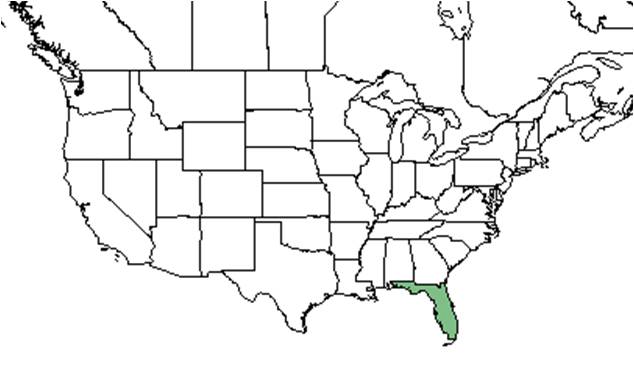Carya floridana
| Carya floridana | |
|---|---|

| |
| Scientific classification | |
| Kingdom: | Plantae |
| Division: | Magnoliophyta - Flowering plants |
| Class: | Magnoliopsida - Dicotyledons |
| Order: | Juglandales |
| Family: | Juglandaceae |
| Genus: | Carya |
| Species: | C. floridana |
| Binomial name | |
| Carya floridana Sarg. | |

| |
| Natural range of Carya floridana from USDA NRCS Plants Database. | |
Common name: Scrub hickory
Contents
Taxonomic notes
Description
A description of Carya floridana is provided in The Flora of North America. C. floridana is a long-lived perennial woody species, that can grow up to 20 meters high [1] [2]. It can be identified from other Carya species by having rust-colored scales on the buds and lower leaf surfaces [3].
Distribution
Carya floridana is endemic to central Florida and is the most abundant hardwood in the southern Lake Wales Ridge (McCarthy and Bailey 1992; Myers and White 1987). The range is influenced by edaphic and climatic conditions (McCarthy and Bailey 1992).
Ecology
Habitat
In the Coastal Plain in Florida, C. floridana has been found in sand pine woods with Lyonia ferruginea; sand pine-oak scrubs; sand ridge scrubs; hardwood hammocks; scrub oak-wiregrass ridges; and scrub barrens (FSU Herbarium). It is an aggressive invader of open xeric woodlands; however, nutrient availability and water limit seedling survival (McCarthy and Bailey 1992; Myers 1990). Soil types include entisols, Astatula-Paola-Tavares of the series Quartzipsamments (McCarthy and Bailey 1992). Associated species include Persea, Quercus laevis, Q. myrtifolia, Q. geminata, Q. chapmanii, Sabal etonia, Serenoa repens, Polygonella, Ceranthera, Ilex cumulicola, Pinus elliottii var. densa, and Garberia (FSU Herbarium).
Phenology
Flowers are monecious, flowering January through April and fruiting June through October [2](FSU Herbarium).
Seed dispersal
Seeds are dispersed by wind and it is self fertile [2].
Seed bank and germination
C. floridana does not have the seed dormancy trait that can be found in commercial hickories of the eastern deciduous forest (McCarthy and Bailey 1992). Hickories have one of the longest taproots observed among the eastern hardwoods, this allows them to resprout repeatedly following heavy disturbances (McCarthy and Bailey 1992). Adequate moisture is needed for seed germination (McCarthy and Bailey 1992).
Fire ecology
Pollination
The following Hymenoptera families and species were observed visiting flowers of Carya floridana at Archbold Biological Station (Deyrup 2015):
Apidae: Apis mellifera
Use by animals
Diseases and parasites
Conservation and Management
Cultivation and restoration
Photo Gallery
References and notes
Deyrup, M.A. 2015. Database of observations of Hymenoptera visitations to flowers of plants on Archbold Biological Station, Florida, USA.
Florida State University Robert K. Godfrey Herbarium database. URL: http://herbarium.bio.fsu.edu. Last accessed: October 2015. Collectors: L.J. Brass, D. Burch, Brevard, A.F. Clewell, R.F. Christensen, Angus Gholson, R.K. Godfrey, R. Kral, O. Lakela, Robert J. Lemaire, S.W. Leonard, Walter S. Judd, K.M. Meyer, John B. Nelson, R.W. Simons, A. Townesmith, D.B. Ward, R.H. Wnek. States and Counties: Florida: Brevard, Highlands, Indian River, Lake, Marion, Martin, Palm Beach. Compiled by Tall Timbers Research Station and Land Conservancy.
- ↑ [Florida Native Plant Society]Accessed: December 4, 2015
- ↑ 2.0 2.1 2.2 [Plants for a Future] Accessed: December 4, 2015
- ↑ [[1]] Accessed: December 4, 2015